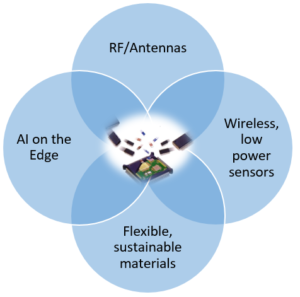Smart Sensing Systems for living and working
Since the 1990’s researchers in both academia and industry have been exploring ways to exploit the potential of Wireless Sensor Networks (WSNs), revolutionising our understanding of and interaction with the world around us. Over the past 20 years, WSNs have developed into a major research area.
In the past decade, the Wireless Sensor Networks (WSN) group at the Tyndall National Institute, has been at the forefront of this research. Our work on embedded systems has been driven by a vision of ubiquitous deployment, extended lifetime and low power consumption, providing information-rich data streams wirelessly in (close to) real-time.
As part of the smart sensing research clusters in Tyndall National Institute (Human Centric Systems, Smart Agriculture and Bio-Electronics), WSN researchers are working to develop sensing solutions that have real societal impact and address some of the grand challenges apparent in the world around us. Within the research clusters, WSN smart systems researchers have a number of goals. We aim to reduce the burden on healthcare systems by making a substantive contribution to the Healthy Living agenda, specifically addressing staying healthy and living and working in health promoting environments through the development of smart sensing systems on and around the body. These wireless sensing devices will provide real time datasets and information regarding peoples’ activities, physiological health information at work and at home. These Human Centric Systems will inform an individuals’ decision making capability regarding their wellbeing needs. We are also working on smart manufacturing applications. We aim to support industry by developing AI-based Human Machine Interfaces, and collaborative robotic capability enabling interoperability in the workplace using smart connectivity platforms with edge capability.
Tyndalls smart sensing system solutions are based on a holistic approach, collecting, combining and analysing environmental, occupational and human health-related data, for analytics at the edge (of the edge) of the cloud, to provide real time data sets for informed decision making in relevant application domains. The research platforms underpinning the smart systems research include:
- RF/Antenna design for around/on/in body communications;
- Wireless, low power sensing systems: batteryless NFC sensors, integrated circuits and MEMs for around/on/in body sensing;
- Flexible Materials and Systems Integration: sustainable and biocompatible materials for human centric, “zero power” wearable applications;
- AI on the Edge: edge analytics for on-device M/L models, interoperable platforms, human machine interfaces, 5G

Optical Aerosol Sensors From Photoacoustics to Evanescent Field Sensing
In the talk, the activities of the Institute of Electrical Measurement and Sensor Systems at the Graz University of Technology in the field of aerosol sensing will be presented. The attention will be paid to several topics covering air quality assessment related to combustion sources as well as design aspects for miniaturized on-chip sensors.In the first part, new methods developed within the Horizon 2020 funded project City Air Remote Emission Sensing (CARES) for the remote detection of traffic-related particle emissions will be presented. These particles are of major concern since studies suggest severe health effects leading to premature deaths even at low levels of exposure. The second part deals with challenges in miniaturizing aerosol sensors. A close-meshed and wide-area monitoring has up to now failed due to the size, complexity and cost of the currently available sensor concepts. The aim of this work is to explore the possibility to use novel aerosol sensing concepts for PM2.5 sensing. Major aspects of the sensor design are the compatibility to standard CMOS processes combined with System in Package (SiP) solutions leading to cost efficiency and relatively easy scalability, which both are premises for a dense sensor network. The third part shows first results of a recently developed low cost, low energy Black Carbon (BC) sensor. BC is of special interest due to its global warming as well as toxic potential.
Bringing chip-integrated NDIR gas sensors into IoT applications
Air sensors for everyone, everywhere! Air quality concerns all of us. The last few years we have been aware that indoor air quality strongly affects our cognitive performance as well as our health. Also, it is well known that outdoor air quality affects our health. Optical Non-Dispersive Infra-Red (NDIR) gas sensors are known to be the reliable and maintenance free alternative for air quality monitoring, but today they are too large and expensive for true mass-implementation. The route to turn the existing NDIR technology into IoT applications includes MOEMS technology using the evanescent field of chip-integrated folded waveguides too sense gas. It also includes 2D-materials, such as graphene, to be integrated on the chip for infra-red light detection as well as machine learning algorithms and geo-tagging for truly maintenance free operation. At the end of the tunnel we see air quality sensors that can be integrated in smart devices such as watches and phones, that will provide real-time data with high spatial resolution. Available for everyone, everywhere.
Outdoor air quality in Stockholm measured using geo-tagging and a low-cost NDIR sensor.






